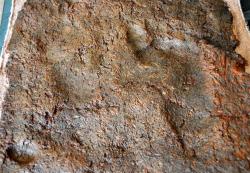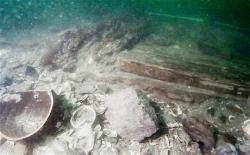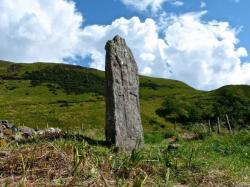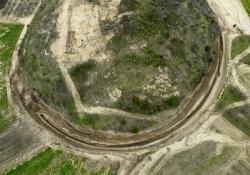INSTITUT SUPERIEUR D'ANTHROPOLOGIE
INSTITUTE OF ANTHROPOLOGY
ONLINE COURSES / COURS A DISTANCE
FALL TERM : OCTOBER 2014
REGISTER NOW
TURQUIE –  Barçın - Footprints dating back to the Neolithic period (6,400 B.C.) have been discovered during excavations in Barçın tumulus in the northwestern province of Bursa’s Yenişehir district. Koç University academic, Rana Özbal, said works had been continuing in Barçın tumulus since 2007 under the coordination of the Culture and Tourism Ministry and the Dutch Research Institute. She said the oldest settlement in the region dated back to 8,600 B.C., adding, “The houses in tumulus are semidetached. In one of the houses, we have found a pair of footprints and now we are searching for how they appeared.” “The floor of the house was plastered. When the plaster was still wet, the footprints remained on the floor. Sometime later the house burned down. Thanks to this fire, the prints have remained until now. According to radiocarbon estimations, the footprints date back to 6,450 B.C,” she added. Even though several footprints were discovered during the Marmaray excavations in Istanbul, Özbal claimed that the ones in Yenişehir were much older. Conservation expert Evren Kıvançer, who is working on the footprints, said those prints could not be kept in the excavation area. “To make it an artwork, we had to take these footprints from the excavation area and stabilize them. The prints had become hard thanks to the fire. This made our work easier,” Kıvançer said, adding “these prints are good enough to tell us the person’s height, weight and even gender.”
Barçın - Footprints dating back to the Neolithic period (6,400 B.C.) have been discovered during excavations in Barçın tumulus in the northwestern province of Bursa’s Yenişehir district. Koç University academic, Rana Özbal, said works had been continuing in Barçın tumulus since 2007 under the coordination of the Culture and Tourism Ministry and the Dutch Research Institute. She said the oldest settlement in the region dated back to 8,600 B.C., adding, “The houses in tumulus are semidetached. In one of the houses, we have found a pair of footprints and now we are searching for how they appeared.” “The floor of the house was plastered. When the plaster was still wet, the footprints remained on the floor. Sometime later the house burned down. Thanks to this fire, the prints have remained until now. According to radiocarbon estimations, the footprints date back to 6,450 B.C,” she added. Even though several footprints were discovered during the Marmaray excavations in Istanbul, Özbal claimed that the ones in Yenişehir were much older. Conservation expert Evren Kıvançer, who is working on the footprints, said those prints could not be kept in the excavation area. “To make it an artwork, we had to take these footprints from the excavation area and stabilize them. The prints had become hard thanks to the fire. This made our work easier,” Kıvançer said, adding “these prints are good enough to tell us the person’s height, weight and even gender.”
http://www.hurriyetdailynews.com/ancient-footprints-discovered-in-bursa-.aspx?pageID=238&nid=71168&NewsCatID=375
JAPON -  Surveying and exploring sunken ships on the seafloor off Japan’s coasts could reveal new historical facts and information.About 500 such sites have been confirmed in Japanese waters. On the seabed off Matsuura, Nagasaki Prefecture, lie the remains of a military vessel thought to have sunk during the Mongolian invasions of Japan in the 13th century. It was discovered three years ago by a research group from the University of the Ryukyus. Items including spherical fragmentation bombs, which were drawn as “tetsuhau” (grenades) in “Moko Shurai Ekotoba,” illustrated narratives of the Mongolian invasions, were found at the site and recovered. The sea area near this site is home to what is known as the Takashima Kozaki site. This was the first submerged site in Japan to be registered as a national historic site. Furthermore, underwater exploration of the area was conducted this summer. The Seto Inland Sea is the final resting place for the Iroha Maru, the ship carrying Sakamoto Ryoma that collided with a ship run by the feudal Kishu domain during the final days of the Tokugawa shogunate. Furnishings thought to have been used in the ship’s cabins have already been retrieved from the site. Chinese ceramics from about the 13th century have been found in the sea near Ojikajima island, which is one of the Goto Islands that are part of Nagasaki Prefecture and have served as key traffic lane on the sea route to China from ancient times.
Surveying and exploring sunken ships on the seafloor off Japan’s coasts could reveal new historical facts and information.About 500 such sites have been confirmed in Japanese waters. On the seabed off Matsuura, Nagasaki Prefecture, lie the remains of a military vessel thought to have sunk during the Mongolian invasions of Japan in the 13th century. It was discovered three years ago by a research group from the University of the Ryukyus. Items including spherical fragmentation bombs, which were drawn as “tetsuhau” (grenades) in “Moko Shurai Ekotoba,” illustrated narratives of the Mongolian invasions, were found at the site and recovered. The sea area near this site is home to what is known as the Takashima Kozaki site. This was the first submerged site in Japan to be registered as a national historic site. Furthermore, underwater exploration of the area was conducted this summer. The Seto Inland Sea is the final resting place for the Iroha Maru, the ship carrying Sakamoto Ryoma that collided with a ship run by the feudal Kishu domain during the final days of the Tokugawa shogunate. Furnishings thought to have been used in the ship’s cabins have already been retrieved from the site. Chinese ceramics from about the 13th century have been found in the sea near Ojikajima island, which is one of the Goto Islands that are part of Nagasaki Prefecture and have served as key traffic lane on the sea route to China from ancient times.
http://heritageofjapan.wordpress.com/
CHINE - Qishan- A bronze chariot made during the Western Zhou Dynasty (c. 11th century-771 BC) has been found in Qishan county, Shaanxi province - and archaeologists believe it may be a ceremonial vehicle used by princes. "We found the chariot, which was buried 1.2 meters underground, in farmland at the village of Hejia," Zhang Yawei, director of the county's Zhouyuan Museum, told China Daily on Saturday. "We were surprised that it is large with a high bronze content." Experts from the School of Archaeology at Peking University, the Shaanxi Provincial Institute of Archaeology and Zhouyuan Museum found the chariot on Aug 18 after investigating the site for 10 days. "It is 2.4 meters long and 1.8 meters wide, and the two wheels are 1.4 meters in diameter," Zhang said. The wheel rims were made from lengths of bronze 15 cm thick and 5 cm wide. The wooden spokes had rotted away during the 3,000 years the chariot was buried in the ground. "The bronze wheels are very rare," said Lei Mingming, a member of the team from the Shaanxi archaeology institute. "The wheels of chariots from the Western Zhou Dynasty that have been found previously were made of wood covered with a 1-cm layer of bronze." The bones of three or four horses were found in front of the chariot. "The number of horses can only be confirmed after the excavation is completed," Lei said. The left side of the chariot has been uncovered while part of the right side remains buried. The excavation work is expected to continue for a month. A large number of bronze items with exquisite ornamentation were found around the chariot, which is thought to be a ceremonial vehicle used by high-ranking royal figures above the level of princes. "One point that supports the preliminary conclusion that it is a ceremonial chariot is that we did not discover any weapons," said Lei Xingshan, professor of the School of Archaeology at Peking University. "According to historical records, there was less warfare in the peak period of the Western Zhou Dynasty."
http://www.ecns.cn/2014/09-01/132412.shtml
USA - Brooklyn - State archaeologists are excavating the buried remains of an 1851 home owned by former slave Priscilla Baltimore, the founder of Brooklyn, in an effort to get the entire village listed on the National Register of Historic Places. It may be a tricky endeavor given that Brooklyn, often cited as the oldest black community in the United States, in the 20th century came to depend on income from its adult entertainment district as a revenue source to run village government. While strip clubs are the town's main business, the 650-population community was founded around 1830 by slaves led by Baltimore who fled St. Louis in the hope of finding freedom in the Illinois backwoods. The village's motto -- "Founded by chance, sustained by courage" -- reflects the ideals of its founders. Brooklyn is also home to one of the earliest African Methodist Episcopal churches, Quinn Chapel, located about a block west of the Baltimore homesite. The church, founded in Philadelphia in 1816, started in Brooklyn in 1825, said member George McShan. The chapel is housed in a building built in 1873.
http://www.bnd.com/2014/08/31/3377135/brooklyn-founded-by-former-slaves.html?sp=/99/166/
FRANCE –  Châteauroux - La rénovation du quartier Saint-Christophe, à Châteauroux, a permis la mise à jour de vestiges d'une église du XIIe siècle et de sépultures d'enfants datant de la même époque.
Châteauroux - La rénovation du quartier Saint-Christophe, à Châteauroux, a permis la mise à jour de vestiges d'une église du XIIe siècle et de sépultures d'enfants datant de la même époque.
VIDEO = http://www.dailymotion.com/video/x249ot5_video-decouvertes-archeologiques-etonnantes-a-chateauroux_news
ROYAUME UNI –  Lochaber - A high-tech community archaeology project could reveal worn carvings on an historic Lochaber standing stone. The Bronze Age monolith in Camas nan Geall Bay at Kilchoan on the Ardnamurchan peninsula stands in a dramatic location looking west out over the sea, but with steep slopes on the other sides. The standing stone, together with a nearby 18th century burial ground, is designated as a Scheduled Monument and therefore of national importance. Members of Ardnamurchan Community Archaeology group have spent a weekend working with the Archaeology Community Co-Production of Research Data (Accord) project, which trains local groups in the digital recording of archaeological monuments. Each of the seven volunteers taking part snapped 50-100 images of the standing stone, which measures 7ft 6ins high by 3ft wide, from every conceivable angle, including above by using a camera on a pole. And the best of these are being used to create a digital 3D model of the monument. This standing stone has an early medieval cross incised in the stone, but it is likely that it is of earlier origin, probably Bronze Age, and has been reused at a later date. The presence of the cross suggests that there could have been an early medieval chapel in the bay.
Lochaber - A high-tech community archaeology project could reveal worn carvings on an historic Lochaber standing stone. The Bronze Age monolith in Camas nan Geall Bay at Kilchoan on the Ardnamurchan peninsula stands in a dramatic location looking west out over the sea, but with steep slopes on the other sides. The standing stone, together with a nearby 18th century burial ground, is designated as a Scheduled Monument and therefore of national importance. Members of Ardnamurchan Community Archaeology group have spent a weekend working with the Archaeology Community Co-Production of Research Data (Accord) project, which trains local groups in the digital recording of archaeological monuments. Each of the seven volunteers taking part snapped 50-100 images of the standing stone, which measures 7ft 6ins high by 3ft wide, from every conceivable angle, including above by using a camera on a pole. And the best of these are being used to create a digital 3D model of the monument. This standing stone has an early medieval cross incised in the stone, but it is likely that it is of earlier origin, probably Bronze Age, and has been reused at a later date. The presence of the cross suggests that there could have been an early medieval chapel in the bay.
https://www.pressandjournal.co.uk/fp/news/highlands/330226/digital-project-could-reveal-secrets-of-highland-standing-stone/
GRECE –  Amphipolis - Video footage of tomb from the air,The video below gives us a bird’s eye view of the Amphipolis Tomb and reveals the size and the grandeur of the excavations came to light on Wednesday. This exquisite footage was taken from a helicopter by a Greek channel, it clearly shows the area covered by the monument while giving a taste of the difficulties and time-consuming nature of the operations.The archaeologists involved in the excavation are focusing on the maintenance and protection of the findings.
Amphipolis - Video footage of tomb from the air,The video below gives us a bird’s eye view of the Amphipolis Tomb and reveals the size and the grandeur of the excavations came to light on Wednesday. This exquisite footage was taken from a helicopter by a Greek channel, it clearly shows the area covered by the monument while giving a taste of the difficulties and time-consuming nature of the operations.The archaeologists involved in the excavation are focusing on the maintenance and protection of the findings.
VIDEO = https://www.youtube.com/watch?v=Js7KBBek_G0